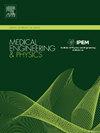A wireless intraoperative joint force sensing system for total hip arthroplasty
IF 1.7
4区 医学
Q3 ENGINEERING, BIOMEDICAL
引用次数: 0
Abstract
A wireless sensor-instrumented femoral head was developed that enables the intraoperative measurement of three force components in a total hip arthroplasty (THA). The design of the head was 32 mm in diameter with a 12/14 taper at the bottom, being compatible with commonly available THA. Inside the femoral head, there are three Hall effect sensors paired with permanent magnets, along with a microprocessor, a Bluetooth wireless module, a noncontact reed switch, and three lithium button batteries, all components were hermetically encapsulated. These components work together to measure and transmit the hip forces applied to the head during surgery. Through bench-top calibration, the system demonstrated a mean measurement error of approximately 8 % for forces up to 800 N. Additionally the practical applications of the prosthesis were tested on three hips from two cadavers undergoing THA. The hip forces were successively measured as the hip was passively moved, revealing insights into the potential for anterior or posterior dislocations with dislocation-prone positions. Understanding these intraoperative hip forces could aid surgeons in making the optimal decisions regarding implant placement and component selection, to minimize the risk of postoperative complications such as dislocation. Overall, this sensor-instrumented prosthesis will be useful for quantifying intraoperative hip forces.
全髋关节置换术中无线关节力传感系统
开发了一种无线传感器股骨头,可以在全髋关节置换术(THA)中测量术中三个力分量。头部的设计为直径32毫米,底部为12/14锥度,与常用的THA兼容。股骨头内部有三个与永磁体配对的霍尔效应传感器,以及一个微处理器、一个蓝牙无线模块、一个非接触式簧片开关和三块锂纽扣电池,所有组件都被密封封装。这些部件一起工作来测量和传递手术过程中施加到头部的髋关节力。通过台式校准,该系统显示了高达800牛顿力的平均测量误差约为8%。此外,在两具接受THA的尸体的三个髋关节上测试了该假体的实际应用。当髋关节被动移动时,连续测量髋关节力,揭示易脱位的前位或后位脱位的可能性。了解术中髋关节受力可以帮助外科医生做出关于植入物放置和部件选择的最佳决策,以最大限度地减少脱位等术后并发症的风险。总的来说,这种传感器假体将有助于量化术中髋关节力。
本文章由计算机程序翻译,如有差异,请以英文原文为准。
求助全文
约1分钟内获得全文
求助全文
来源期刊

Medical Engineering & Physics
工程技术-工程:生物医学
CiteScore
4.30
自引率
4.50%
发文量
172
审稿时长
3.0 months
期刊介绍:
Medical Engineering & Physics provides a forum for the publication of the latest developments in biomedical engineering, and reflects the essential multidisciplinary nature of the subject. The journal publishes in-depth critical reviews, scientific papers and technical notes. Our focus encompasses the application of the basic principles of physics and engineering to the development of medical devices and technology, with the ultimate aim of producing improvements in the quality of health care.Topics covered include biomechanics, biomaterials, mechanobiology, rehabilitation engineering, biomedical signal processing and medical device development. Medical Engineering & Physics aims to keep both engineers and clinicians abreast of the latest applications of technology to health care.
 求助内容:
求助内容: 应助结果提醒方式:
应助结果提醒方式:


